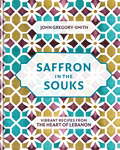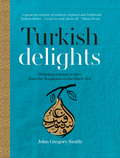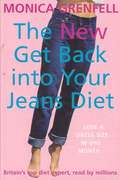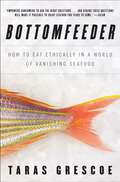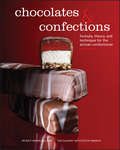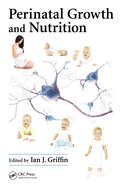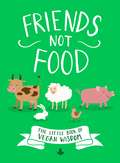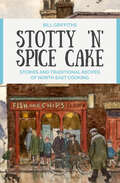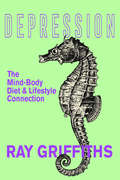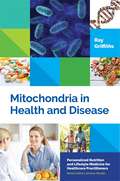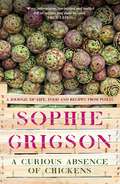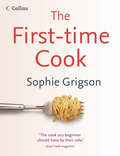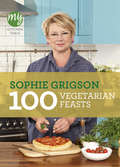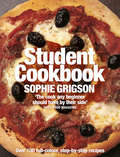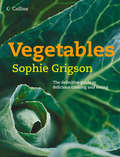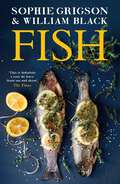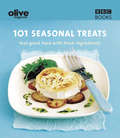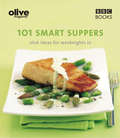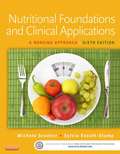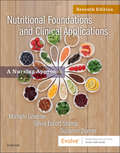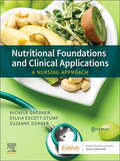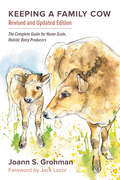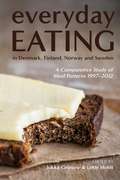- Table View
- List View
Saffron in the Souks: Vibrant recipes from the heart of Lebanon
by John Gregory-SmithFrom the vibrant souks of Tripoli and Beirut to the quiet calm of the Chouf Mountains and Qadisha Valley, Lebanon is a land of bold colours, exquisite flavours and hidden beauty. For this gorgeous book, John Gregory-Smith travelled the length and breadth of the country to bring back the very best of Lebanese cuisine. Classic streetfood, delicate pastries and little known Druze recipes are given John's signature twist, creating dishes that are bursting with flavour and sure to become star players in your kitchen. With stunning location photography to bring the country to life, Saffron in the Souks is sure to delight and inspire its readers.
Turkish Delights: Stunning regional recipes from the Bosphorus to the Black Sea
by John Gregory-SmithIn Turkish Delights John Gregory-Smith brings his passion for Turkey and its food to your kitchen. He celebrates the best of the country's traditional food with 100 regional dishes, giving each one his simple, modern spin. Forget greasy late-night doner kebabs, John offers the Iskender kebab from the city of Bursa in Northwest Turkey, filled with finely sliced tender lamb, hot tomato and garlic sauce and yogurt. Other tempting dishes include the Ilgin Beef Kofta (pepper and parsley spiked beef from the Central Anatolian region) or his Ottoman-inspired Stuffed Pepper Dolma. With chapters on Breakfast, Meze, Pide and Kofta, Kebabs, Salads, Meat, Seafood, Vegetables and Desserts and Drinks, it is crammed full of exciting flavours and inspiring ideas.
The New Get Back Into Your Jeans Diet
by Monica GrenfellMonica Grenfell's original GET BACK INTO YOUR JEANS DIET continues to help thousands of women achieve their ideal size and shape. Based on a nutritious programme of carbohydrates that control your moods and never leave you hungry or craving 'binge' foods, plus manageable and effective exercises, this plan is designed to achieve the loss of one dress size per month. THE NEW GET BACK INTO YOUR JEANS DIET debunks the misguided low-carbohydrate approach, and has a revised plan that makes it easier than ever to choose and manage your daily food intake. Monica's refreshing no-nonsense style tells you exactly what input you need to make for success, putting you in control. With firm muscles, low body fat and measurable inch-loss, you can wear those favourite garments with confidence, and without unsightly bulges or wobbles. Monica's foolproof inch-loss and weight-loss plan trains you to sustain a balanced diet and exercise programme that will keep you lithe for years to come.
Bottomfeeder: How to Eat Ethically in a World of Vanishing Seafood
by Taras GrescoeDividing his sensibilities between Epicureanism and ethics, Taras Grescoe set out on a nine-month, world-wide search for a delicious-and humane-plate of seafood. Along the way, he explains the cultural and commercial implications of fish production on our environment, our health, and our seas. At once entertaining and illuminating, Bottomfeeder is a thoroughly enjoyable narrative about the world's cuisines and an examination of the fishing and farming practices we take too easily for granted.
Chocolates and Confections: Formula, Theory, and Technique for the Artisan Confectioner
by Peter P. Greweling The Culinary Institute of AmericaThe comprehensive guide to chocolate and candy making for professionals and serious home cooks Chocolate and candy making is more popular and accessible than it has ever been. This book combines artisan confectionery techniques with straightforward explanations of the theory, science, and formulas at work. Fundamental information includes ingredient function and use, chocolate processing, and artisan production techniques. Professionals and home enthusiasts will find formulas and variations for gorgeous and delectable confections including dairy-based centers, crystalline and non-crystalline sugar confectionery, jellies, nut centers, and aerated confections. Expanding on the award-winning first edition, this new revision provides the same comprehensive content, foolproof formulas, and step-by-step instructions readers expect, along with the very latest information and guidelines. Revised to include 30 percent new recipes and formulas, more than 250 photos, and 27 illustrations Features new sections on opening a professional bakeshop, packaging and marketing, and American-style layered candy bars Written by Certified Master Baker Peter Greweling, one of the world's top names in confections, and author of Chocolates and Confections at Home with The Culinary Institute of America, from Wiley
Perinatal Growth and Nutrition
by Ian J. GriffinPreterm infants grow poorly after birth and very commonly develop ex utero growth restriction (EUGR). However, the risks and benefits of catch-up growth in preterm infants must be weighed, and evidence addressing this warrants examination. Perinatal Growth and Nutrition explores the reasons for EUGR and the long-term effects on developmental outcom
Friends Not Food: The Little Book of Vegan Wisdom
by Alison GriffithsChickens, Cows, Ducks, Sheep, Pigs, Rabbits, Trout, Salmon, Prawns, Lobsters - all of the animal kingdom - are not here for us to eat, we should be looking after them.Friends Not Food is a celebration of our relationship with our animal friends and is packed with vegan sayings as well as facts about both those animals and the industries that prey on them.The perfect gift for anyone who loves animals!
Stotty 'n' Spice Cake: Stories and traditional recipes of North East cooking
by Bill GriffithsStotty ‘n’ Spice Cakebrings together regional recipes, dialect, social history and kitchen technology to give us an insight into how kitchen skills, tools and diets have developed. Bill Griffiths takes us on a journey through cooking history - from the griddle on an open fire and the ‘beehive’ oven to the widely used, much loved and polished kitchen range (th’ yuven). This book describes the changing tastes – as well as changes in supplies of meat, fish and grain over the years to include traditions such as the popularity of oatcakes, broth and bread. Recipes from across the region, such as Leak Pudding, Carlins, Singin’-hinny, Taffle Apple, Barley Broth and wartime recipes ‘Warton Pie’ (Wartime Pie) of course, all served with much home grown North East humour. A joyous celebration of the history of the food and its people from the North East of England.
JapanEmoji!: The Characterful Guide to Living Japanese
by Ed GriffithsDo you know what most of the emojis on your phone mean? Understanding their meaning is to understand modern Japan. Experience everyday Japanese living and discover the quirks and secrets from the home of Ikigai and forest bathing with this smart, playful guide.
Depression: The Mind-Body, Diet and Lifestyle Connection
by Ray GriffithsThe part of the brain most heavily associated with mental health, memory, emotion and mood is called the hippocampus; the biological name for the seahorse. It is the unusual seahorse-like shape of the hippocampus that has led to its evocative name. Just as the seahorse charms the depths of oceans, our own hippocampus, when supported and nurtured, can help to enchant our own lives. Worryingly, there are an increasing number of scientific papers linking problems with the hippocampus to depression, in particular, the shrinking or failure to regrow this part of the brain after prolonged stress. Depression, anxiety and mood disorders are often seen as entirely psychological in cause. However, more and more research is highlighting that chronic health issues, poor diet and lifestyle choices can, and will, negatively impact our vulnerable hippocampus, and consequently, our mental health.Personalised nutritionist Ray Griffiths examines how we can modify our dietary and lifestyle choices to nourish our brain and hippocampus. These choices can help to cushion us from the harm we may encounter as we navigate the challenges of modern everyday life. This nourishment is absolutely vital, as every day our hippocampus can potentially regrow 700 brand new neurons, but it needs a huge amount of assistance to do so. Nourishment for the hippocampus can come from not just diet but also from balanced gut bacteria, social connection, exercise, an outdoors environment, music and dance. Learning how to support your brain health begins with what you eat.
Mitochondria in Health and Disease: Personalized Nutrition for Healthcare Practitioners (Personalized Nutrition and Lifestyle Medicine for Healthcare Practitioners)
by Ray Griffiths Lorraine NicolleWhat are the functions of mitochondria in the human body? Why might they stop working properly and what can happen as a result? How can personalized nutrition help to optimize mitochondrial function and prevent or address chronic conditions? This innovative book explores the incredibly complex biochemical roles of mitochondria in health and disease. When healthy, mitochondria provide us with ninety percent of our body's energy. When unhealthy, this can lead to many chronic and degenerative conditions including cancer and Alzheimer's disease. This guide helps practitioners to identify the mitochondrial dysfunction underlying a wide range of health complaints, and provides inspiration about relevant and emerging mitochondria-supportive dietary regimes and nutrients to explore within the model of personalized nutrition.
A Curious Absence of Chickens: A journal of life, food and recipes from Puglia
by Sophie Grigson'My first thought on reading A Curious Absence of Chickens is that Jane Grigson, the best cookery writer in my lifetime, would have been so proud of her daughter. Sophie Grigson has written twenty odd excellent cookbooks, but I think this is the best of them. It is her first book for a decade and was obviously driven by a real love of her subjects, which are Puglia, people and food. It is witty, informative, fascinating and stuffed full of recipes you want to cook.' Prue Leith'Puglia is a region I wanted to get to know intimately, to understand culture, life, history and geography, reflecting through the prism of the food that's put on the tables of locals and tourists, too. I'm reminded of my 20-year old self, scribbling in notebooks as I first travelled through Italy's south, only this time I'm back to stay.'After her children grew up and left home, Sophie Grigson found herself living alone. About to turn 60, she took the decision to sell or give away most of her belongings, to pack up her car and to drive to Puglia on her own to start a new life. In a part of Italy where she didn't know anyone, having last visited the region 40 years ago, this narrative book of food writing, stories and recipes brings to life the region, its food and the local characters that she meets along the way. This is a book about courage, hope, new horizons and, above all, delicious food.
The First-Time Cook
by Sophie GrigsonSetting up home for the first time and feel lost in the kitchen? ‘The First-time Cook’ is a one-stop guide which shows you not only how to cook delicious food but also how to understand ingredients and techniques so you can feel completely confident cooking on your own.
My Kitchen Table: 100 Vegetarian Feasts (My Kitchen #19)
by Sophie GrigsonSophie Grigson's passion for vegetarian food shines through every recipe in this gorgeous collection. From light summery salads to root vegetable soups, Mediterranean pastas and Middle Eastern stews, this book will entice all readers, whether you are a vegetarian or not.
The Student Cookbook
by Sophie GrigsonLeaving home to go to university is daunting enough already without the added stress of cooking for yourself. If you've never ventured into the kitchen or can't tell a saucepan from a frying pan renowned TV chef, Sophie Grigson is here to help.
Vegetables: The Classic Every Kitchen Must Have
by Sophie GrigsonA definitive guide to cooking with vegetables, with essential information on buying, preparing and cooking the vast range now available, from one of the most trusted and knowledgeable cookery writers working today.
Fish
by Sophie Grigson William Black'Initially I was surprised by just how little time it takes to cook fish. Sometimes seconds will do, and you seldom need to spend more than a few minutes when cooking a fillet of fish. Yes, precision is vital to avoid overcooking, but quite honestly there is no great mystery to it.'Originally published in 1998 and shortlisted for the Best Food Book in the 1999 Glenfiddich Food and Drink Awards, FISH has now been fully updated by Sophie Grigson.In FISH, Sophie creates accessible modern-day recipes for both the novice and the experienced cook. From Halibut with Welsh Rarebit Crust and Maryland Crabcakes, to Greek Octopus and Red Wine Stew and Lobster Thermidor, there are recipes for all tastes - plus helpful tips on buying, storing and preparing fish from William Black.This is the only book you will ever need on fish and fish cookery.
Olive: Feel-good Food With Fresh Ingredients (Olive Magazine Ser.)
by Lulu GrimesAs Olive readers know, food is best enjoyed when it is in season and this handy little cookbook will inspire you to get cooking all year round. 101 Seasonal Treats provides ideas for every time of year so that you can create a culinary feast with ease and flair. Each recipe is accompanied by a full-colour picture ensuring winning results every time.
Olive: Slick Ideas For Weeknights In (Olive Magazine Ser.)
by Lulu GrimesReaders of BBC's Olive magazine will love these delicious, sophisticated supper recipes, designed to impress everyone around the dinner table. It's always nice to treat yourself to something special and the food experts at Olive magazine have come up with 101 failsafe recipes, each accompanied by a full-colour picture so you that you can create that extra-special dish with ease. You'll never be stuck for meal ideas with this handy little cookbook.
Nutritional Foundations and Clinical Applications - E-Book: A Nursing Approach
by Michele Grodner Sylvia Escott-Stump Suzanne DornerLooking at nutrition and nutritional therapy from the nurse’s perspective, Nutritional Foundations and Clinical Applications: A Nursing Approach takes a wellness approach based on health promotion and primary prevention. It offers guidelines with a human, personal touch, using first-hand accounts to show how nutrition principles apply to patients in real-world practice. This edition includes new chapters on the effects of stress on nutrient metabolism and on nutrition for neurodegenerative disorders such as Alzheimer’s and Parkinson’s disease. Written by educators Michele Grodner, Sylvia Escott-Stump, and Suzie Dorner, this leading nutrition text promotes healthy diets and shows how nutrition may be used in treating and controlling diseases and disorders.Applying Content Knowledge and Critical Thinking/Clinical Applications case studies help you apply nutrition principles to real-world practice situations.Health Debate and Social Issue boxes explore controversial health issues and emphasize ethical, social, and community concerns, so that you can develop your own opinions.Cultural Considerations boxes highlight health issues and eating patterns related to specific ethnic groups to help you approach, interview, and assess patients from diverse populations.Teaching Tool boxes include strategies for providing nutrition counseling to patients.Personal Perspective boxes offer first-hand accounts of interactions with patients and their families, demonstrating the personal touch for which this book is known.Key terms and a glossary make it easy to learn key vocabulary and concepts.Website listings at the end of every chapter refer you to related sites for additional research and study. NEW! Nutrition for Neuro-Psychiatric Disorders chapter covers neurodegenerative disorders such as Alzheimer’s and Parkinson’s disease and psychiatric disorders such as depression and bipolar disorders. NEW! Nutrition in Metabolic Stress: Burns, Trauma, and Surgery chapter examines the effects of stress on nutrient metabolism and starvation along with severe stress due to surgery and trauma. NEW organization for the clinical chapters includes: 1) Disorder: background and implications, 2) Food and nutrition therapies, 3) Education: Teaching Tool boxes.UPDATED content reflects changes to Healthy People 2020 and the Dietary Guidelines for Americans 2010.UPDATED! The Nursing Approach box analyzes a realistic nutrition case study in terms of the nursing process, demonstrating practical ways nurses can use nutrition in practice and process.
Nutritional Foundations and Clinical Applications - E-Book: A Nursing Approach
by Michele Grodner Sylvia Escott-Stump Suzanne DornerFocusing on nutrition and nutritional therapy from the nurses’ perspective, Nutritional Foundations and Clinical Applications: A Nursing Approach, 7th Edition takes a wellness approach based on health promotion and primary prevention It offers guidelines with a human, personal touch, using first-hand accounts to show how nutrition principles apply to patients in real-world practice. This new edition incorporates the most current guidelines and information on key nutrition topics throughout as well as expanded coverage on the role of inflammation in common disease. A favorite of nursing students and instructors, this leading nutrition text promotes healthy diets and shows how nutrition may be used in treating and controlling diseases and disorders.Personal Perspective boxes offer first-hand accounts of interactions with patients and their families, demonstrating the personal touch for which this book is known.Applying Content Knowledge and Critical Thinking/Clinical Applications case studies help you learn to apply nutrition principles to real-world practice situations.Social Issue boxes emphasize ethical, social, and community concerns on local, national international levels to reveal the various influences on health and wellness.Teaching Tool boxes include strategies for providing nutrition counseling to patients.Health Debate boxes prepare you for encountering differing opinions or controversies about food, nutrition, and health concerns.Key terms and a glossary make it easy to learn key vocabulary and concepts. NEW! Completely updated content throughout incorporates the latest dietary guidelines and most current information on topics such as good vs. bad fats, nutrition during pregnancy, microbiota/probiotics/prebiotics, and more.NEW! Cultural Diversity and Nutrition sections in each chapter highlight health issues and eating patterns related to specific ethnic groups to help you approach, interview, and assess patients from diverse populations.NEW! Enhanced coverage of health literacy equips you with strategies for enhancing patient education for those with low literacy skills.NEW! Additional Nursing Approach boxes analyze realistic nutrition case studies from the perspective of the nursing process.NEW! Expanded coverage of inflammation highlights its pivotal role in conditions such as obesity, cancer, heart disease, and diabetes.
Nutritional Foundations and Clinical Applications - E-Book: A Nursing Approach
by Michele Grodner Sylvia Escott-Stump Suzanne DornerNEW! Nursing Approach sections include Next Generation NCLEX® terminology as well as single-episode cases and questions, with answers on the Evolve website.
Keeping a Family Cow: The Complete Guide for Home-Scale, Holistic Dairy Producers, 3rd Edition
by Joann S. GrohmanThe cow is the most productive, efficient creature on earth. She will give you fresh milk, cream, butter, and cheese, build human health and happiness, and even turn a profit for homesteaders and small farmers who seek to offer her bounty to the local market or neighborhood. She will provide rich manure for your garden or land, and will enrich the quality of your life as you benefit from the resources of the natural world. Quite simply, the family that keeps a cow is a healthy family. Originally published in the early 1970s as The Cow Economy and reprinted many times over, Keeping a Family Cow has launched thousands of holistic small-scale dairy farmers and families raising healthy cows in accordance with their true nature. The book offers answers to frequently asked questions like, 'Should I get a cow?' and 'How Much Space do I need?' in addition to extensive information on: • The health benefits of untreated milk; • How to milk a cow effectively and with ease; • Choosing your dairy breed; • Drying off your cow; • Details on calving and breeding; • The importance of hay quality and how to properly feed your cow; • Fencing and pasture management; • Housing, water systems, and other supplies; • Treating milk fever and other diseases and disorders; • Making butter, yogurt, and cheese, and, of course . . . • . . . Everything else the conventional dairy industry doesn’t tell us! Now revised and updated to incorporate new information on the raw milk debate, the conversation about A1 vs. A2 milk, fully grassfed dairies, more practical advice for everyday chores, and updated procedures for cow emergencies. Keeping a Family Cow has not only stood the test of time, it still remains the go-to inspirational manual for raising a family milk cow nearly forty years after its first publication. Joann Grohman has a lifetime of practical experience that has been bound into this one volume and presented in the spirit of fun and learning.
Everyday Eating in Denmark, Finland, Norway and Sweden: A Comparative Study of Meal Patterns 1997-2012
by Jukka Gronow Lotte HolmThe chapters in this volume concentrate on the mundane and ordinary eating practices of the everyday, showing how these are linked to change in modern society. The contributors present a collection of systematic empirical results from a unique study based on representative samples of four Nordic populations - Denmark, Finland, Norway and Sweden - conducted at two time points, 15 years apart. The results of this unprecedented longitudinal survey leads the contributors to question many commonly held beliefs about the presumed and feared collapse of the traditional eating habits, family meals, and regular meal patterns. As the social organization of eating is in many ways related to developments in other social institutions such as family, education, and work, chapters provide interesting insights into contemporary society, with key topics selected for scrutiny including gender, food types, diet and health, and cooking practices. Additionally, the chapters highlight changes in the gendering of food practices and signs of increasing informality around meals.
Everyday Eating in Denmark, Finland, Norway and Sweden: A Comparative Study of Meal Patterns 1997-2012
by Jukka Gronow Lotte HolmThe chapters in this volume concentrate on the mundane and ordinary eating practices of the everyday, showing how these are linked to change in modern society. The contributors present a collection of systematic empirical results from a unique study based on representative samples of four Nordic populations - Denmark, Finland, Norway and Sweden - conducted at two time points, 15 years apart. The results of this unprecedented longitudinal survey leads the contributors to question many commonly held beliefs about the presumed and feared collapse of the traditional eating habits, family meals, and regular meal patterns. As the social organization of eating is in many ways related to developments in other social institutions such as family, education, and work, chapters provide interesting insights into contemporary society, with key topics selected for scrutiny including gender, food types, diet and health, and cooking practices. Additionally, the chapters highlight changes in the gendering of food practices and signs of increasing informality around meals.
